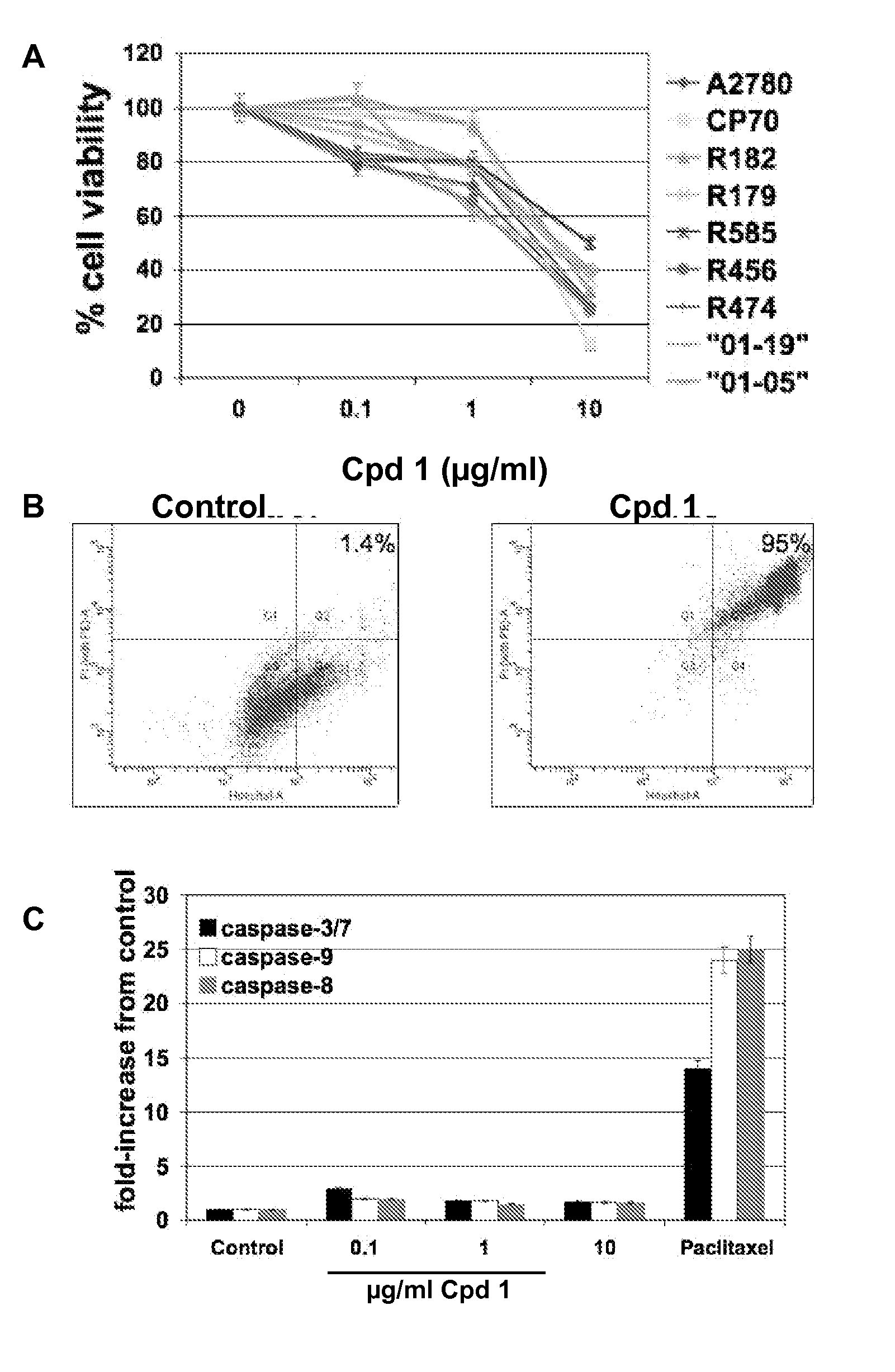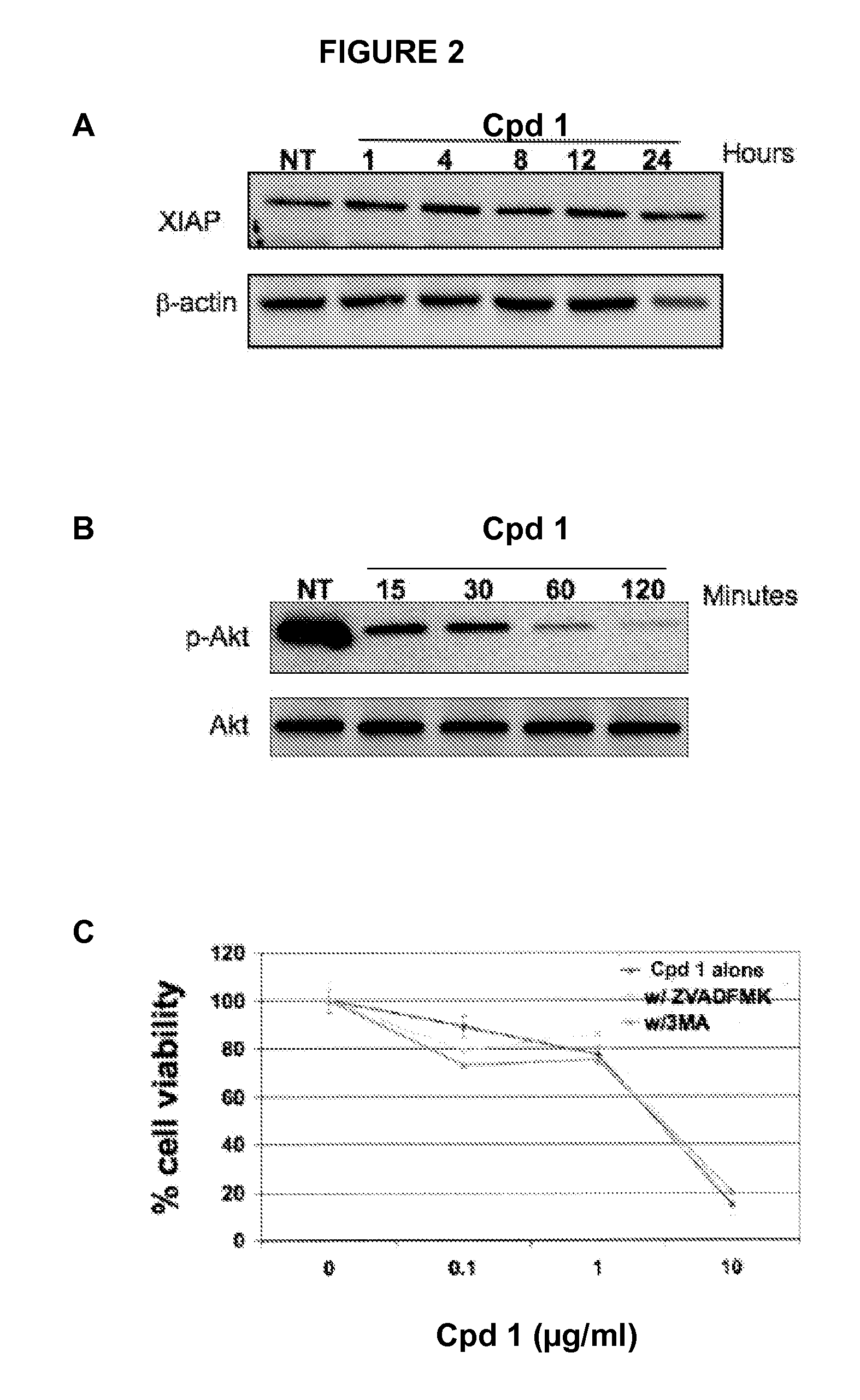Methods for inducing programmed cell death
a cell death and programmed cell technology, applied in the field of programmed cell death, can solve problems such as cell death, and achieve the effect of promoting caspase-independent apoptosis
- Summary
- Abstract
- Description
- Claims
- Application Information
AI Technical Summary
Benefits of technology
Problems solved by technology
Method used
Image
Examples
example 1
Compound 1-Induced Cell Death Involves Caspase-Independent DNA Fragmentation
[0188]Compound 1 has been found to decrease cell viability in a range of cancer cells including some EOC cell lines (data not shown). Therefore, the inventors' first objective was to determine the effect of Compound 1 on a panel of primary cultures of EOC cells isolated from either ascites or tumor tissue, which include cultures that are paclitaxel-resistant (R182, R456) (Kelly et al, 2006). These cultures express high levels of the anti-apoptotic proteins XIAP and FLIP (16). Paclitaxel-sensitive, as well as paclitaxel-resistant cultures showed a significant reduction in the percentage of viable cells after treatment with Compound 1 with GI50 between 5 and 10 μg / ml (FIG. 1A).
[0189]To determine if the decrease in cell viability was due to apoptosis, cells were stained with Hoechst and Propidium Iodide (PI) and analyzed by flow cytometry. In addition, the activity of caspases-3 / 7, -8, and -9 was measured and t...
example 2
Autophagy is Not Required for Cell Death Induced by Compound 1
[0191]Morphologically, Compound 1 treated EOC cells contained large intracellular vacuoles (FIG. 4B) that stained positively with acridine orange (data not shown) thereby suggesting that Compound 1 induces autophagic cell death. To determine whether the process of autophagy is involved, the levels of phosphorylated mTOR (p-mTOR), a major regulator of the autophagic pathway, and one of its targets, ribosomal p70 S6 kinase (p-S6k) were determined. In addition, the levels of the autophagic marker LC3-II were determined. Western blot analyses showed that p-mTOR and p-S6k were down-regulated 15 mins post-Compound 1 treatment (FIG. 3A) followed by a significant increase in the levels of LC3-II (FIG. 3B) confirming the activation of the autophagic pathway.
[0192]To determine if the process of autophagy is the primary mechanism of Compound 1-induced cell death, cells were treated with Compound 1 (10 μg / ml) in the presence or absen...
example 3
Mitochondrial Depolarization, Mitochondrial Translocation and Nuclear Translocation
[0194]Control and treated cells were stained with JC-1 dye, a cationic fluorescent dye that stains intact mitochondria red and shifts to green during mitochondrial depolarization. When compared to vehicle control, immunofluourescent images of Compound 1 treated cells were mostly green in appearance (FIG. 4). This observed shift in JC-1 spectrum from red to green in Compound 1 treated cells confirms that Compound 1 is able to induce mitochondrial depolarization. This shift was confirmed by flow cytometry, which showed 30% (1 h) and 50% (4 h) of cells having depolarized mitochondria post-Compound 1 treatment (FIG. 5).
[0195]The stability of the mitochondrial membrane is partly controlled by the Bcl2 family of proteins characterized by their conserved BH domains. Bid and Bax are cytoplasmic proteins that translocate to the mitochondria to initiate depolarization. In contrast, Bcl2 is a resident mitochondr...
PUM
| Property | Measurement | Unit |
|---|---|---|
| Time | aaaaa | aaaaa |
| Cell growth | aaaaa | aaaaa |
Abstract
Description
Claims
Application Information
 Login to View More
Login to View More - R&D Engineer
- R&D Manager
- IP Professional
- Industry Leading Data Capabilities
- Powerful AI technology
- Patent DNA Extraction
Browse by: Latest US Patents, China's latest patents, Technical Efficacy Thesaurus, Application Domain, Technology Topic, Popular Technical Reports.
© 2024 PatSnap. All rights reserved.Legal|Privacy policy|Modern Slavery Act Transparency Statement|Sitemap|About US| Contact US: help@patsnap.com










